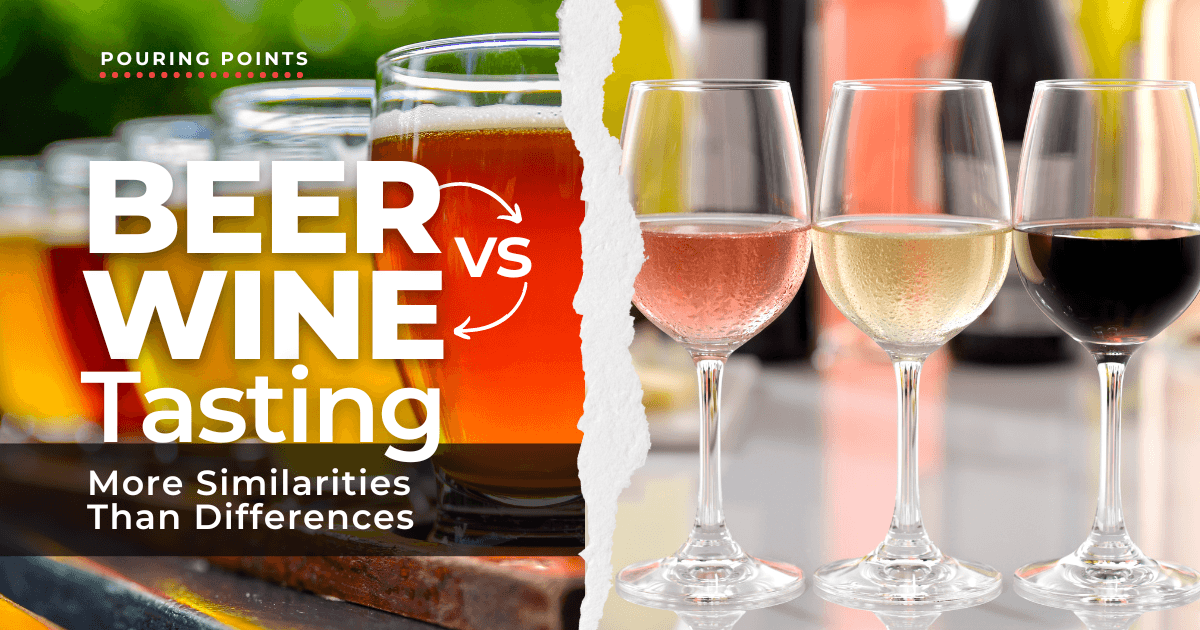Beer vs Wine Tasting: More Similarities Than Differences
Many wine and beer enthusiasts would have us think that the tasting assessment of beer and wine are completely different processes, diametrically opposed to one another in almost every possible way. And who could blame them? The malt-driven flavors of beer and the fruitiness of wine are seemingly at odds with one another.
But are they really so different? And can we find some commonality when we’re tasting them? I believe so.
Let’s start with the appearance.
Wine color runs along two color spectrums and relies on the pigment in the grape skins and the wine’s exposure to oxygen. The lightest white wines (from white grapes) can be as light as straw or lemon, darkening to gold, amber and finally brown. Red wines can be ruby or purple, but with oxidation can transform into garnet and tawny.
In contrast, beer color is dictated by the malt. The easiest way to remember beer color is to think about the color spectrum of toast. Starting with straw, beer can attain colors of gold, amber, red, brown and black (that’s some burnt toast) and every shade in between. Beer color then, is akin to the color of white wine (straw, gold, brown) and red wine (ruby).
Beer is famous for the foam that sits atop it. When assessing foam, we can again look at color (white, tan or even brown), the size of the foam and its stability. Wine typically doesn’t have foam, save for sparkling wines. Unfortunately, wine foam lacks the protein content of beer, so the stability of the large exploding bubbles is fleeting. However, its mere presence does bring up another similarity.
Finally, we can look at the clarity of beer and wine. Typically, both are naturally hazy, full of proteins and polyphenols, so some form of filtration takes place, whether physical or chemical. However, there is a trend for unfiltered beer and wine—a haze craze. Think En Rama Sherry, an unfiltered fortified wine from Jerez, and Hazy IPAs, a style of beer with a turbid appearance, where producers argue that removing the haze can reduce the complexity and intensity of the beverages.
So, while the appearance of beer and wine can be similar in unfiltered and unfined examples, it is a fact that a lot of wine—especially white wine, is typically lucid.
Let’s move on to aromas and flavors.
The intensity of the aroma and flavors is yet another similarity these beverages share. From a holistic perspective of the aroma, a taster can assess the overall intensity of a beer or wine, from light to pronounced. The aroma can also be broken down into separate characteristics and assessed individually for their intensity. Another similarity.
With wine, you’re analyzing the aromas, flavors, and even textures that result from the winemaking process. Similarly, with beer, the flavors that arise from the malt, hops, and yeast are assessed.
Many of these characteristics, particularly from the grapes (wine), hops (beer), and yeast (a shared ingredient), are comparable, with fruitiness being key to the style of many wines and beers. Many of the same aroma and flavor compounds can be found in both beverages, such as floral characteristics, fruits (green, citrus, stone, tropical, red, and black), herbal and spice notes, yeast, and malolactic characteristics, along with oak and tertiary attributes.
Obviously, not all wines and beers will share all of these characteristics. Still, there are certainly examples for all of these aroma and flavor characteristics. .
Onto the structure of beer and wine, and interestingly, there are a lot of similarities here.
Sweetness: Most beers and wines are fairly dry with quite low levels of residual sugar. Of course, there are styles of wine (e.g., Sauternes) and beer (e.g., Milk Stout) that are sweet. Beer sweetness will often have a creaminess to it from the use of lactose, while the perception of sweetness is the result of sugar sweetness, and in the case of wine, the ripeness of grapes and any residual sugar. Sweetness can provide balance, particularly against any high levels of acidity in a sweet wine like Sauternes, while in beer, it will balance the roasted flavors in the milk stout.
Acidity: Both wine and beer are acidic. Typically, wine is more acidic, with a pH between 3.0 and 3.6. The pH of beer is usually higher, usually somewhere between 4.0 – 4.5; however, some styles are every bit as acidic and refreshing as wine; think Flanders beers, Lambics, and Berliner Weisse, with pHs ranging from 3.2 – 3.5. The significant difference between these sour beers and wines is the acid type. While wine is dominated by tartaric acid (tastes unmistakably like wine), sour beers will be dominated by lactic acid (tastes like sauerkraut), while a small number will have acetic acid (tastes like vinegar).
Tannin/Bitterness: Tannins are an important structural component in wine that can help provide balance and help the wine develop during maturation. Tannin, whether from grape skins or barrels, tends to produce an astringent feeling inside the mouth—with wine, it can feel grippy, gritty, or even pixelated. The equivalent in beer is the bitterness and the astringent texture it can provide. Bitterness comes from the boiling of hops, with the isomerization of alpha acids. As with grape tannins, the bitterness from hops can have a drying effect on the palate.
Body: The body, or thickness, of beer and wine, runs the gamut, with some examples being thin and watery, while others are thick, dense, and chewy. The biggest influence on the perception of body is alcohol—the higher the alcohol by volume, the fuller the body. However, other influences enhance the perception of body, including residual sugar (in beer’s case, unfermentable carbohydrates – dextrins).
Finish: One of the perks of drinking beer and wine is that you will continue to taste them after you have swallowed (or spat). These could be structural characteristics, like acidity, sweetness or bitterness, or they could be flavor characteristics like fruit, oak or chocolate. Usually, the longer the finish, the higher the quality.
As you can see, beer and wine share a lot of similarities. Chances are, if you’re a proficient wine taster, you would probably make a handy beer taster as well (and vice versa). Needless to say, pleasure and intrigue can be derived from both beverages.
Interested in WSET Beer Certifications: Click Here













